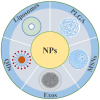The Mechanism and Latest Research Progress of Blood-Brain Barrier Breakthrough
- PMID: 39457617
- PMCID: PMC11504064
- DOI: 10.3390/biomedicines12102302
The Mechanism and Latest Research Progress of Blood-Brain Barrier Breakthrough
Abstract
The bloodstream and the central nervous system (CNS) are separated by the blood-brain barrier (BBB), an intricate network of blood vessels. Its main role is to regulate the environment within the brain. The primary obstacle for drugs to enter the CNS is the low permeability of the BBB, presenting a significant hurdle in treating brain disorders. In recent years, significant advancements have been made in researching methods to breach the BBB. However, understanding how to penetrate the BBB is essential for researching drug delivery techniques. Therefore, this article reviews the methods and mechanisms for breaking through the BBB, as well as the current research progress on this mechanism.
Keywords: adsorption-mediated transport; blood–brain barrier; carrier-mediated transport; cerebrovascular disease; passive diffusion; receptor-mediated transport.
Conflict of interest statement
The authors declare no conflicts of interest.
Figures




Similar articles
-
Crossing the Blood-Brain Barrier: Recent Advances in Drug Delivery to the Brain.CNS Drugs. 2017 Feb;31(2):109-133. doi: 10.1007/s40263-016-0405-9. CNS Drugs. 2017. PMID: 28101766 Review.
-
A method to predict different mechanisms for blood-brain barrier permeability of CNS activity compounds in Chinese herbs using support vector machine.J Bioinform Comput Biol. 2016 Feb;14(1):1650005. doi: 10.1142/S0219720016500050. Epub 2015 Oct 27. J Bioinform Comput Biol. 2016. PMID: 26632324
-
Does VEGF secreted by leukemic cells increase the permeability of blood-brain barrier by disrupting tight-junction proteins in central nervous system leukemia?Med Hypotheses. 2011 May;76(5):618-21. doi: 10.1016/j.mehy.2010.12.001. Epub 2011 Mar 12. Med Hypotheses. 2011. PMID: 21398042
-
Pathways for small molecule delivery to the central nervous system across the blood-brain barrier.Perspect Medicin Chem. 2014 Jun 16;6:11-24. doi: 10.4137/PMC.S13384. eCollection 2014. Perspect Medicin Chem. 2014. PMID: 24963272 Free PMC article.
-
The blood-brain barrier: clinical implications for drug delivery to the brain.J R Coll Physicians Lond. 1994 Nov-Dec;28(6):502-6. J R Coll Physicians Lond. 1994. PMID: 7884704 Free PMC article. Review.
Cited by
-
The Application of Polymeric Nanoparticles as Drug Delivery Carriers to Cells in Neurodegenerative Diseases.Cell Prolif. 2025 Aug;58(8):e13804. doi: 10.1111/cpr.13804. Epub 2025 Feb 11. Cell Prolif. 2025. PMID: 39931916 Free PMC article. Review.
References
Publication types
Grants and funding
LinkOut - more resources
Full Text Sources

